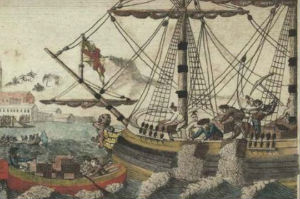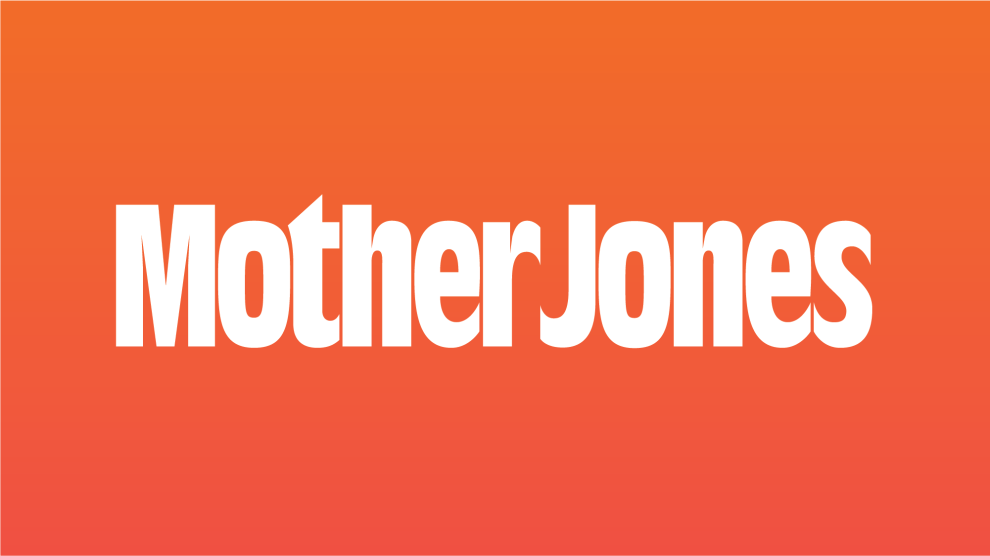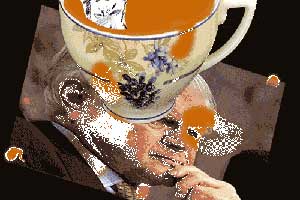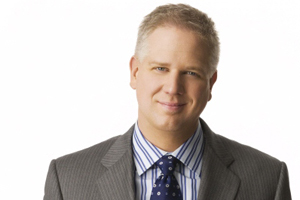
W.D. Cooper / <a href="http://commons.wikimedia.org/wiki/File:Boston_Tea_Party-Cooper.jpg">Wikimedia</a>
This story first appeared on the TomDispatch website.
On a winter’s day in Boston in 1773, a rally of thousands at Faneuil Hall to protest a new British colonial tax levied on tea turned into an iconic moment in the pre-history of the American Revolution. Some of the demonstrators—Sons of Liberty, they called themselves—left the hall and boarded the Dartmouth, a ship carrying tea, and dumped it overboard.
One of the oddest features of the Boston Tea Party, from which our current crop of Tea Party populists draw their inspiration, is that a number of those long-ago guerilla activists dressed up as Mohawk Indians, venting their anger by emitting Indian war cries, and carrying tomahawks to slice open the bags of tea. This masquerade captured a fundamental ambivalence that has characterized populist risings ever since. After all, if in late eighteenth century America, the Indian already functioned as a symbol of an oppressed people and so proved suitable for use by others who felt themselves put upon, it was also the case that the ancestors of those Boston patriots had managed to exterminate a goodly portion of the region’s Native American population in pursuit of their own self-aggrandizement.
Today’s Tea Party movement, like so many of its “populist” predecessors, is a house of contradiction, a bewildering network of crosscutting political emotions, ideas, and institutions. What connects it powerfully to a populist past stretching all the way back to Boston Harbor is, however, a sense of violation: “Don’t Tread on Me.”
Despite a recurring resistance to the impositions of powerful outside forces—anti-elitism has been axiomatic for all such insurgencies—populist movements have differed greatly on just what those forces were and what needed to be done to free people from their yoke. It’s worth noting, for instance, that an earlier invocation of the Boston Tea Party took place at a 1973 rally on a replica of the Dartmouth—a rally called to promote the impeachment of President Richard Nixon.
From the Know-Nothings to the People’s Party
Over the course of American history, the populist instinct, now resurgent in the Tea Party movement, has oscillated between a desire to transform, and so create a new order of things, and a desire to restore a yearned-for (or imagined) old order.
Before the Civil War, one such movement that caught both these urges was colloquially dubbed the “Know-Nothings” (not for any anti-intellectualism, but because its members deliberately conducted much of their business in secret—hence, if questioned, were instructed to say, “I know nothing”). Know-nothing-ism exuded the desire to move forward and backward at the same time. During the 1840s and 1850s, it swept across much of the country, North and South. There were “know-nothing” candies, “know-nothing” toothpicks, and “know-nothing” stagecoaches.
Soon enough, the movement evolved into a national political party, the American Party, that appealed to small farmers, small businessmen, and working people. Its attraction was two-fold. The party vociferously opposed Irish and German Catholic immigration to the US (as well as that of Chinese and Chilean immigrants working in the gold fields of California). Yet, in the North, it also denounced slavery. As planks in a political program, nativism and anti-slavery might seem like an odd couple, but in the minds of the party’s followers they were joined at the hip. As Know-Nothings saw it, the Papacy and the South’s slave-owning planter elite were both conspiring to undermine a democratic society of masterless men.
Keep in mind that conspiratorial thinking has long been deeply embedded in American populist movements (as in the Tea Party today). In nineteenth century protestant America, alleged plots by Vatican hierarchs were a recurrent feature of political life. In the North, a wave of crime and the rise of “poor relief” and other forms of dependency—including wage labor, which accompanied the arrival of a flood of impoverished Catholic immigrants—seemed to threaten an American promise of a society of free, equal, and self-reliant individuals (supposedly so noxious to the priestly elite of the Catholic Church). In the slave South, where the master class was believed to be hard at work subverting the Constitution, conspiratorial machinations were self-evidently afoot. By the mid-1850s, most “Know-Nothings” in the North had found their way into the newborn Republican Party which combined hostility to slavery with a milder form of anti-Catholicism.
 Populism with a capital “P,” the great economic and political insurgency of the last third of the nineteenth century that blanketed rural America from the cotton South to the grain-growing Great Plains and the Rocky Mountain West, would bear its own distinctive ambivalence. The People’s Party indicted corporate and finance capitalism for destroying the livelihoods and lives of independent farmers and handicraftsmen. It also attacked big business for subverting the foundations of democracy by capturing all three branches of government and transforming them into coercive instruments of rule by a new plutocracy. Populists sometimes attributed what they termed an American “counterrevolution” to the conspiratorial plots of the “great Devil Fish of Wall Street,” suspected of colluding with Great Britain’s elite to undo the American Revolution.
Populism with a capital “P,” the great economic and political insurgency of the last third of the nineteenth century that blanketed rural America from the cotton South to the grain-growing Great Plains and the Rocky Mountain West, would bear its own distinctive ambivalence. The People’s Party indicted corporate and finance capitalism for destroying the livelihoods and lives of independent farmers and handicraftsmen. It also attacked big business for subverting the foundations of democracy by capturing all three branches of government and transforming them into coercive instruments of rule by a new plutocracy. Populists sometimes attributed what they termed an American “counterrevolution” to the conspiratorial plots of the “great Devil Fish of Wall Street,” suspected of colluding with Great Britain’s elite to undo the American Revolution.
The remedies proposed, however, were hardly those of Luddites. These instead anticipated many of the fundamental reforms of the next century, including government subsidies for farmers, the graduated income tax, direct election of the Senate, the eight-hour day, and even the public ownership of railroads and public utilities. A tragic movement of the dispossessed, the Populists yearned to restore a society of independent producers, a world without a proletariat and without corporate trusts. Yet they also envisioned something new and transformative, a “cooperative commonwealth” that would escape the barbaric competitiveness and exploitation of free market capitalism.
The Great Plains of Resentment
For the next four decades, populism remained emphatically against corporate capitalism and held on tightly to its resentment of powerful outsiders as well as a penchant for conspiracy mongering. During the 1930s, however, the location of Conspiracy Central began to shift from Wall Street and the City of London to Moscow—and even New Deal Washington. Anti-communism added a new ingredient to an already roiling American politics of fear and paranoia, a toxic element which still inflames the Tea Party imagination two decades after the Berlin Wall was torn down.
During the 1936 presidential campaign, in the midst of the Great Depression, three populist movements—Louisiana Senator Huey Long’s “Share Our Wealth” clubs, the Union for Social Justice formed by the charismatic “radio priest” Father Charles E. Coughlin, and Francis Townsend’s campaign for government pensions for the elderly—coalesced, albeit briefly and uneasily, to form the Union Party. It ran from the left against President Franklin Roosevelt, nominating as its presidential candidate North Dakota Congressman William Lemke, a one-time spokesman for radical farmers. (The vice-presidential candidate was a labor lawyer from Boston.)
The Union Party expressed a broad dissatisfaction with the failure of Roosevelt’s New Deal to relieve economic distress and injustice. Senator Long, the latest in a long line of Southern populist demagogues, had been decrying the power of land barons, “moneycrats,” and big oil since his days as Louisiana’s governor. His “Share Our Wealth” plan called for pensions and public education for all, as well as confiscatory taxes on incomes over $1 million, a minimum wage, and public works projects to give jobs to the unemployed. Townsend’s scheme was designed to solve unemployment and the penury of old age by offering monthly government pensions of $200, financed by taxes on business, to everyone over the age of 60. Coughlin, an early supporter of Roosevelt, trained his fire on finance capitalism, inveighing against its usurious, unchristian “parasitism.”
But Long and especially Coughlin were at pains to distinguish their form of radicalism from the collectivism and atheism of the Red menace. Father Coughlin expressed support for labor unions and a just wage. He was, however, an inveterate foe of the left-leaning United Automobile Workers union, and roundly condemned the sit-down strikes which spread like a prairie fire following Roosevelt’s triumphal landslide victory in the 1936 presidential election, as workers across the country occupied everything from auto plants to department stores demanding union recognition.
Indeed, in his radio addresses and his newspaper, Social Justice, the priest ranted about an incongruous conspiracy of Bolsheviks and bankers whose aim was to betray America. He would eventually add a tincture of anti-Semitism to his warnings about a Wall Street cabal. His growing sympathy for Nazism was not so shocking. Fascism, after all, had its roots in a European version of populism that conveyed a post-World War I disgust with the selfishness and incompetence of cosmopolitan ruling elites, a virulent racial nationalism, and a hatred of bankers and especially Bolsheviks.
Followers of Long and Coughlin loathed big business and big government, even though big government—back then anyway—was taking on big business. For them, “Don’t Tread on Me” meant a defense of local economies, traditional moral codes, and established ways of life that seemed increasingly endangered by national corporations as well as the state bureaucracies that began to proliferate under the New Deal. Union Party campaign oratory was filled with references to the “forgotten man,” an image first invoked by Roosevelt on behalf of the working poor.
In the years ahead, kindred images would resurface during a time of turmoil in the late 1960s in Nixon’s appeals to the “silent majority” of “Middle America,” and more recently in the Tea Party’s wounded sense of exclusion. “Forgotten man” populism conveyed the irate politics of resentment of precariously positioned Americans against the organized power blocs of modern industrial society: Big Business, Big Labor, and Big Government.
Race, Resentment, and the Rise of Conservative Populism
Over the last half century populism has drifted steadily rightward, becoming ever more restorationist and ever less transformative, ever more anti-collectivist and ever less anti-capitalist. What were subordinate themes in the older style populism—religious orthodoxy, national chauvinism, phobic racism, and the politics of fear and paranoia—have come to the fore in our time. At least in broad terms, both the Barry Goldwater and the George Wallace insurgencies of the 1960s displayed this trajectory.
Goldwater, the Arizona senator and 1964 Republican candidate for president, an “insurgent”? Yes, if you keep in mind his condemnation of the too-liberal elite running the Republican Party, who, in his eyes, represented a clubby world of Ivy League bankers, corrupt politicians, media lords, and “one-worlders.” Or consider the way he flirted with the freakish John Birch Society (which called President Dwight Eisenhower a “dedicated, conscious agent of the Communist Party” and warned of a Red plot to weaken the minds of Americans by fluoridating the water supply). Or the Senator’s alarming readiness to threaten to push the nuclear button in defense of “freedom,” which could be thought of as the Cold War version of “Don’t Tread on Me.”
Above all, Goldwater was the avatar of today’s politics of limited government. In his opposition to civil rights legislation, he might be called the original “tenther”—that is, a serial quoter of the Tenth Amendment to the Constitution, which reserves for the states all powers not expressly granted to the Federal government, with which he justified hamstringing all efforts by Washington to rectify social or economic injustice. For Goldwater the outlawing of Jim Crow was an infringement of constitutionally protected states’ rights. Moreover, he was an inveterate enemy of all forms of collectivism, including of course unions and the welfare state.
As the Goldwater opposition sank its grassroots into the lush soil of the Sunbelt, its desire to restore an older order of things was palpable. At a time when New Deal liberalism was the reigning orthodoxy, the senator’s reactionary impulses seemed startlingly adrift from the mainstream, and so strange indeed.
Goldwater’s rebellious constituents were an oddly positioned band of rebels. Unlike the declining middling sorts attracted to the Union Party, they came mainly from a rising Sunbelt stratum, a new middle class significantly nourished by the mushrooming military-industrial complex: technicians and engineers, real-estate developers, middle managers, and mid-level entrepreneurs who resented the intrusion of Big Government while in fact being remarkably dependent on it.
They could be described as reactionary modernists for whom liberalism had become the new communism. How shocking when this Arizona “maverick”—he deserved the label far more than John McCain ever did (if he ever did)—won the Republican nomination in a knock-down brawl with the presidium, led by New York Governor Nelson Rockefeller, that had run the party until then. Might the Tea Party accomplish something similar today?
Think of Alabama Governor George Wallace as the other missing link between the economic populism of yesteryear and the cultural populism of the late twentieth century. He was all at once an anti-elitist, a populist, a racist, a chauvinist, and a tribune of the politics of revenge and resentment. “Segregation now, segregation tomorrow, segregation forever”: a line spoken at his inauguration as governor in 1963 that would be his signature defiance of the civil rights revolution and its alliance with the federal government. In no uncertain terms, it signaled the militant racism of his bed-rock supporters.
His appeal, however, ran far deeper than that. The whole tenor of his politicking involved a down-home defense of blue-collar America. Like Huey Long, he was sensitive to the economic predicament of his lower-class constituents. As governor he favored expanded state spending on education and public health, pay raises for school teachers, and free textbooks. When he ran for president as a third party candidate in 1968, he called for increases in social security and Medicare. As late as 1972, Wallace increased retirement pensions and unemployment compensation in Alabama.
Yet he championed the hard-hat American heartland by hailing its ethos of hard work and what today would be known as “family values” far more than by proposing concrete measures to assure its economic well-being. Wallace railed against the know-it-all arrogance of “pointy-headed” Washington bureaucrats, the indolence of “welfare queens,” and the impiety, moral decadence, and disloyalty of privileged long-haired, pot-smoking, anti-war college students.
Bellicose calls for law and order, states’ rights, and a muscular patriotism fueled the revanchist emotions that made Wallace into more than a regional figure. When he ran in the Democratic primaries in 1964 (with the support of the John Birch Society and the White Citizens Council), he won significant numbers of votes not only in the Deep South, but in states like Indiana, Wisconsin, and Maryland, a sign of the Southernization of American politics at a time when the spread of NASCAR, country music, and the blues were Southernizing its culture as well.
Wallace’s venture into third-party politics (on the predictably named American Independent Party ticket) terrified the Democrats, who feared the loss of part of their blue-collar base. He called Vice President Hubert Humphrey, then running for president against Richard Nixon, as well as Northern liberals generally, a “group of god-damned, mealy-mouthed sissy-britches”—shades of Senator Joe McCarthy and the 1950s—and he promised to take the gloves off, if elected, and bomb North Vietnam back to the Stone Age.
Wallace’s popularity revealed a possibility to Nixon and the Republicans denied them since the end of Reconstruction: that, on the road to an Electoral College victory, they might begin to develop a “southern strategy.” In the meantime, his populist cry that there “was not a dime’s worth of difference between the Democratic and Republican parties” won him 10 million votes, 13.5% of the total and 46 votes in the Electoral College. And remember this: a crowd of 20,000 attended a Wallace rally in 1968 at a sold-out Madison Square Garden in New York City.
Don’t Tread on My Taxes
So what does this episodic and checkered history of American populism have to do with the Tea Party?
As a start, the Tea Party movement reminds us that the moral self-righteousness, sense of dispossession, anti-elitism, revanchist patriotism, racial purity, and “Don’t Tread on Me” militancy that were always at least a part of the populist admixture are alive and well. For all the fantastical paranoia that often accompanies such emotional stances, they speak to real experiences—for some, of economic anxiety, insecurity, and loss; for others, of deeper fears of personal, cultural, political, or even national decline and moral disorientation.
Though such fears and feelings are, in part, legacies of the corporate liberal order—one of the dark sides of “progress” under capitalism—in this new populist moment, anti-capitalism itself barely lingers on. Though outrage at the bank bailout did help propel the Tea Party explosion, anti-big-business sentiment is now a pale shadow of its former self, a muted sub-theme in the movement when compared to the Wallace moment, not to mention those of Huey Long or the Populists.
This is hardly surprising since, at least economically, capitalism has, according to recent surveys of Tea Party membership, served many of them reasonably well. Like Goldwater supporters of the 1960s, those who identify with the Tea Party movement are generally wealthier than the population as a whole, and more likely to be employed. They are also apparently better educated, so their fondness for Sarah Palin’s intellectual debilities may be more a case of resentment of bicoastal cultural snobbery than eye-popping ignorance.
Alongside an exalted rhetoric about threats to liberty lies a sour, narrow-minded defensiveness against any possible threat of income redistribution that might creep into the body politic… and so into their pockets. “Don’t Tread on Me,” once a rebel war cry, has morphed into: “I’ve got mine. Don’t dare tax it.” The state, not the corporation, is now the enemy of choice.
Tea Party populism should also be thought of as a kind of identity politics of the right. Almost entirely white, and disproportionately male and older, Tea Party advocates express a visceral anger at the cultural and, to some extent, political eclipse of an America in which people who looked and thought like them were dominant (an echo, in its own way, of the anguish of the Know-Nothings). A black President, a female Speaker of the House, and a gay head of the House Financial Services Committee are evidently almost too much to bear. Though the anti-immigration and Tea Party movements so far have remained largely distinct (even if with growing ties), they share an emotional grammar: the fear of displacement.
But identity politics aside, Tea Party anger reaches far beyond the ranks of the modest Tea Party movement. It resonates with other Americans who understandably feel that political and economic elites, serving themselves at the expense of everyone else, have failed Americans. The big question is just exactly how (or even if) that private and personal rage gets transformed into moral and political outrage. If the heirs of George Wallace and Barry Goldwater, or the Sarah Palins of today, have their way, the outcome won’t be a tea party.
Steve Fraser is editor-at large of New Labor Forum, co-founder of the American Empire Project, a writer, TomDispatch contributor, and an historian. His latest book is Wall Street: America’s Dream Palace.
Joshua B. Freeman teaches history at the City University of New York. He is currently completing a history of the United States since World War II as part of the Penguin History of the US.
This piece is an adaptation of an article that will be published in the Fall 2010 issue of the magazine New Labor Forum.
















